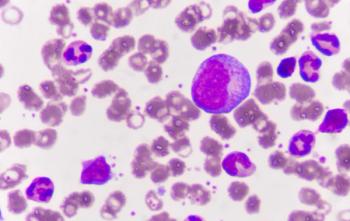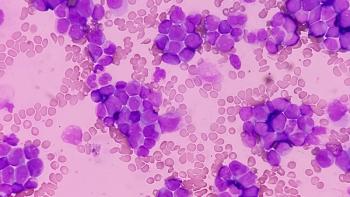
Bevacizumab Combo Appears Effective, Safe for Older Patients With mCRC
The addition of bevacizumab to capecitabine produced favorable efficacy and safety data for older patients with metastatic colorectal cancer.
The combination of bevacizumab (Avastin) to capecitabine (Xeloda) produced favorable efficacy and safety profiles for patients with metastatic colorectal cancer who were 76 years or older, or who were age 65-75 and were ineligible for intensive chemotherapy, including oxaliplatin- and irinotecan-based regimens, according to findings from a phase 2 study (UMIN000005209) conducted in Japan.1
Data from the study, published in the journal In Vivo, demonstrated that patients with mCRC treated with capecitabine plus bevacizumab (n = 33) had a median progression-free survival (PFS) of 10.3 months (95% CI, 9.2-15.4). Of note, the 6- and 12-month PFS rates were 87.5% (95% CI, 76.8%-99.7%) and 35.8% (95% CI, 22.3%-57.3%), respectively.
“This study represents the first phase 2 trial assessing the efficacy of first-line capecitabine plus bevacizumab in Japanese patients with mCRC ineligible for intensive chemotherapy,” the study authors wrote in the publication. “The study met its primary end point [of PFS]. These results underscore the safety and efficacy of first-line capecitabine in combination with bevacizumab as a viable therapeutic option for vulnerable elderly Japanese patients deemed unsuitable for upfront oxaliplatin- or irinotecan-based combination regimens.”
Background and Study Design
Previously, the phase 3 AVEX trial (NCT00484939) demonstrated that first-line capecitabine plus bevacizumab was effective and well tolerated in a global population of patients 70 years of age or older with mCRC.2 Of note, the median PFS was significantly longer with capecitabine plus bevacizumab vs capecitabine alone, at 9.1 months (95% CI, 7.3-11.4) vs 5.1 months (95% CI, 4.2-6.3), respectively (HR, 0.53; 95% CI, 0.41-0.69; P < .0001). With the success of the AVEX study, investigators from the phase 2 study aimed to identify the potential benefits of this combination in Japanese patients.1
Notably, the phase 2 study evaluated the combination in patients with mCRC who were 76 years of age or older, or those 65 to 75 years of age who were ineligible for intensive chemotherapy. Patients were also required to have histologically or cytologically confirmed colon or rectal carcinomas, evaluable disease per RECIST 1.1 criteria, creatinine clearance of at least 30 mL per minute, adequate organ function, a life expectancy of 8 weeks or longer at enrollment, and an ECOG performance score of 0 to 2. Those previously treated with adjuvant or neoadjuvant chemotherapy were eligible for the study if they had completed treatment more than 6 months before enrollment.
The multicenter study evaluated the efficacy and safety of capecitabine at 2000 mg/m2 per day for 14 days with bevacizumab at 7.5 mg/kg on day 1 every 3 weeks until disease progression, intolerable adverse effects (AEs), or withdrawal of consent. Dose modification of capecitabine was allowed if creatinine clearance was below 50 mL per minute at baseline. Patients who experienced grade 2 hand-foot syndrome, grade 4 hematological toxicities, or grade 3/4 nonhematological toxicities were also allowed to receive a reduced dose of capecitabine. Moreover, treatment with capecitabine alone was permitted if toxicities led to a temporary or permanent interruption of bevacizumab.
The primary end point was PFS; secondary end points included overall survival (OS), overall response rate (ORR), and safety.
Baseline Patient Characteristics
Among all patients on the study, the median age was 78 years (range, 67-86); 24.2% of patients were younger than 76 years of age, and 75.8% of patients were at least 76 years of age. Of note, 51.5% of patients were male. ECOG performance statuses consisted of 0 (42.4%), 1 (42.4%), and 2 (15.6%). Furthermore, mCRC histologies included well differentiated (27.3%), moderately differentiated (57.5%), poorly differentiated (6.1%), papillary (6.1%), and unknown (3.0%). KRAS statuses included wild-type (45.5%), mutant (12.1%), and unknown (42.4%). Tumor locations included the colon (60.6%) and the rectum (39.4%). In total, 39.4% of patients had stage IV disease, and 60.6% of patients had recurrent disease. Most patients had undergone prior surgical resection (81.8%).
Additional data of capecitabine/bevacizumab in older patients with mCRC.
Additional Efficacy and Safety Data
In the overall population, the ORR was 30.3% (95% CI, 15.6%-48.7%); all responses were partial. Additionally, 60.6%, and 6.1% of patients had best responses of stable disease, and disease progression, respectively, and 3.0% of patients were not evaluable for response. Additionally, the disease control rate was 91.0% (95% CI, 75.7%-98.1%). The median OS was 27.9 months (95% CI, 24.2-50.1), and the 12- and 24-month OS rates were 93.8% (95% CI, 85.7%-100.0%) and 68.1% (95% CI, 53.5%-86.6%), respectively. The median time to treatment failure was 9.2 months (95% CI, 6.9-11.5).
“Our data demonstrate the good antitumor activity of capecitabine plus bevacizumab as a first-line treatment for patients with mCRC, achieving an overall response rate of 30.3%, which is comparable [with] or even higher than that previously reported in clinical trials,” the study authors noted.
Regarding safety, 75.8% of patients discontinued treatment because of disease progression; 1 patient discontinued treatment and subsequently underwent conversion surgery, and 2 patients discontinued treatment for other reasons. Treatment discontinuations due to treatment-related AEs (TRAEs) were observed in 15.2% of patients; 2 of these patients discontinued treatment due to capecitabine-related TRAEs (hand-foot syndrome and diarrhea). In those treated with bevacizumab, TRAEs included thrombocytopenia, gastrointestinal perforation, and transient ischemic attack. Moreover, 48.5% of patients received further treatment, including an oxaliplatin-containing regimen (21.2%), irinotecan alone or with bevacizumab (12.1%), an anti-EGFR antibody–containing regimen (9.1%), and other therapy (6.1%).
Notably, major grade 3/4 nonhematological toxicities included hypertension (36.0%) and hand-foot syndrome (12.0%). Grade 4 gastrointestinal perforation occurred in 1 patient; grade 3 proteinuria occurred in 2 patients. The major grade 3 hematological toxicities were neutropenia and anemia (1 patient each). No treatment-related deaths were observed.
“These findings suggest that combination therapy with capecitabine and bevacizumab may be well tolerated and potentially effective in elderly and vulnerable Japanese patients with mCRC,” the study authors concluded. “The advantage of the capecitabine plus bevacizumab regimen is that it allows for treatment with fewer toxicities, such as peripheral neuropathy or severe bone marrow suppression, [and maintains] the quality of life during treatment.”
References
- Yamaguchi T, Yoshida M, Taira K, et al. Phase II trial of capecitabine plus bevacizumab for elderly patients with metastatic colorectal cancer: OGSG 1102. In Vivo. 2025;39(3):1505-1513. doi:10.21873/invivo.13950
- Cunningham D, Lang I, Marcuello E, et al. Bevacizumab plus capecitabine versus capecitabine alone in elderly patients with previously untreated metastatic colorectal cancer (AVEX): an open-label, randomised phase 3 trial. Lancet Oncol. 2013;14(11):1077-1085. doi:10.1016/S1470-2045(13)70154-2
Newsletter
Knowledge is power. Don’t miss the most recent breakthroughs in cancer care.
















































































